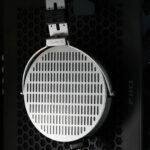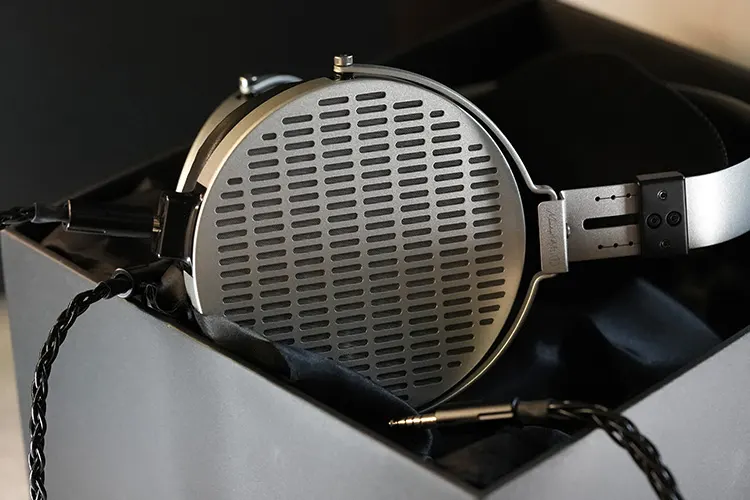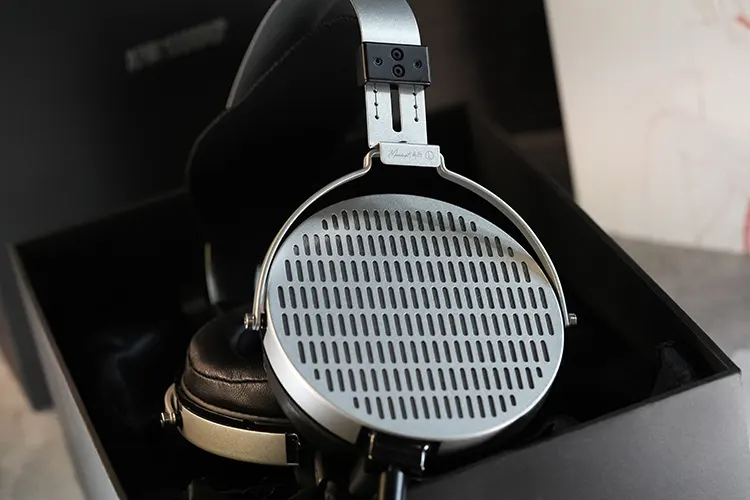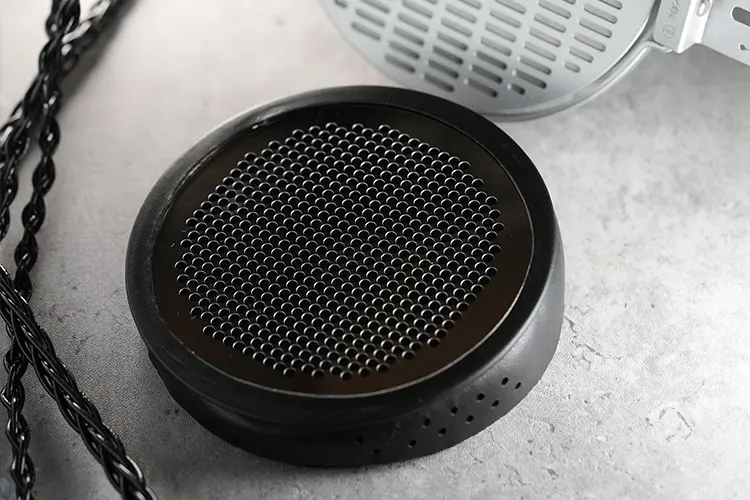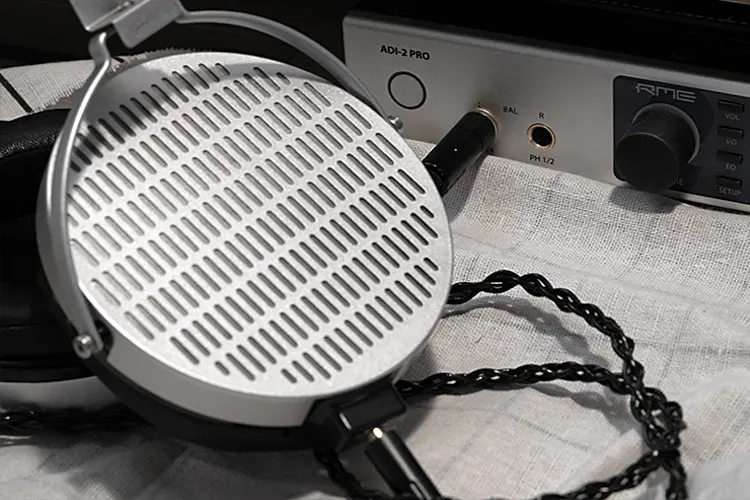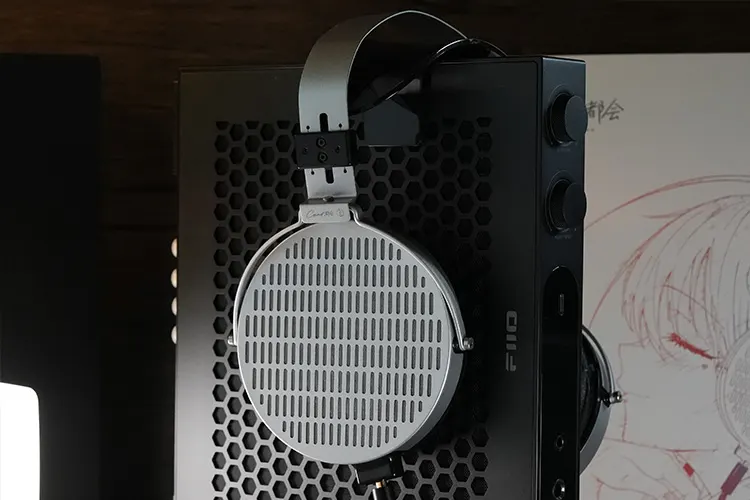In this feature, James reviews the MOONDROP COSMO, which is a new set of flagship 100mm planar driver open-back headphones priced at $899.
Disclaimer: This sample was sent to me in exchange for my honest opinion. Headfonics is an independent website with no affiliate links or status. I thank MOONDROP and Shenzhen Audio for their support.
Click here to read more about MOONDROP products we have previously featured on Headfonics.
Note that this article follows our current scoring guidelines which you can read here in more detail.
The $899 COSMO is MOONDROP’s third Planar Magnetic headphones and current flagship following the release of the VENUS and the PARA in 2022 and 2023 respectively.
The design of the COSMO has some shared features with its predecessors, but there are also some driver upgrades to match that new flagship moniker and higher price tag.
Unlike the PARA, the COSMO is much more demanding in terms of power with what I could best describe as a unique tuning. Read on and we will walk through the features, sound performances, and how it fares against the competition in my full review below.
Features
The MOONDROP COSMO is a set of open-back planar magnetic headphones using a similarly sized 100mm FDT driver with an etched pure silver thin film circuit found in the VENUS and the PARA.
However, this time MOONDROP has gone for what is their thinnest diaphragm to date at 0.500n. Fittingly it’s called a Nanoscale Ultra-thin Diaphragm.
Anyone familiar with HIFIMAN nano-thickness diaphragms from the likes of the Nano up to the Susvara knows a well-implemented ultra-thin planar diaphragm usually excels in a fast response and plenty of detail so that’s what I am expecting here.
The COSMO is rated with a fairly low impedance value of 15Ω±15% (@1kHz) and a sensitivity rating of 100 dB/Vrms (@1kHz)which is increasingly commonplace now with newer planar headphones releases.
On paper, the COSMO is a moderately demanding set of headphones but as you will find out on page 2 of the review it still requires a capable amplifier to sound at its best.
Design
The COSMO is available in a matte silver finish with a framework that has a strong resemblance to the PARA and VENUS.
However, some of the parts and the cable are upgraded. The vented design on the panels isn’t as flashy as on the VENUS with a more uniform and low-profile aesthetic to its appearance this time.
The structure is overall quite rigid with a modern vibe. However, I hope MOONDROP will consider changing the color theme or finishing on the higher-end positioned products so they will look even more distinct for future releases.
Comfort
One thing I like about the MOONDROP COSMO’s design is that there is no need to readjust the headband every time you wear their headphones.
After the first adjustment, the COSMO fits instantly the second time you put it on. The leather earpads are very comfortable though they are slightly soft and thin and not permeable enough to carry a huge staging performance.
After some use, I would recommend you swap these stock pads out for alternative pads such as the ones from the PARA which I find more open-sounding.
Stock Cable
The pure copper cable is terminated with 4.4mm plugs with a thick wire gauge and is accompanied by a 6.35mm SE converter adapter.
The adapter is not something I am used to seeing in included stock accessories for headphone cables. It’s a nice solution for those with SE-only amplifiers without having to throw in an additional SE-terminated cable.
This 8-wire cable touches up the overall design nicely with some attractive square braiding finishing that looks pretty cool.
The stock cable’s copper contributes to the more rounded treble performance on the COSMO. If you want a slightly brighter signature and a more opened-up response, I recommend swapping to SPC or pure silver wire cable alternatives.
Packaging & Accessories
The COSMO comes in the same box size imprinted with their character, there is also a postcard of the same theme plus user manuals.
Everything looks appealing here as usual but I wish MOONDROP would consider adding a small pouch for storage as you will not want the headphones to get dusty or use the box as a long-term storage option.
Sound Impressions
The MOONDROP COSMO was given 100 hours of burn-in with the below impressions compiled using the FiiO R9, K19, RME’s ADI 2 Pro, the Soncoz SGA1, and the Shanling M5 Ultra for both source and amplification.
Summary
From the specifications and features the COSMO seems to be combining the traits of the PARA and VENUS, and in practice it is more power-demanding, scaling with better decoding and more powerful amplification.
The COSMO has a rather mid-centric tuning that highlights the vocal performance. Particularly with nasal tones and its harmonics, there is a rather steep roll-off that smooths out sibilance in the treble zone and the bass is quite airy with the sub-bass faintly detectable.
It is also obvious that the stock pad suppresses the potential openness from the COSMO. Just by lifting the cups slightly off the ear to increase the distance of the driver and letting more air through, the presentation immediately becomes more spacious sounding.
In a similar sense, you can swap to other thicker, well-ventilated pads to enhance the transparency, boosting clarity and naturalness in the mid-range and enhancing the overall balance.
Bass
Testing on the FiiO K19, the bass is moderately deep while maintaining good agility and texture. Whereas on less powerful gears the bass may come across as thinner and less extended.
When sufficiently powered there is good fullness in the bass, which helps the COSMO sound more expressive with improved control over decay.
Bass instruments sound punchy and intimate with sufficient air, though it may get boxy with the stock pads when the bassline gets more complicated.
Testing on the RME ADI 2 Pro gives me a similar impression, adding a bit more texture and depth which helps the bass to sound more layered and cleaner.
The vocal sounds less ‘brilliant’ on the K19 though the body is more clearly defined and separated, which helps darker voices and male vocalists to sound more expressive and natural.
Giving both ends of the spectrum a small nudge in EQ further enhances transparency, air, and balance. This in turn helps instruments sound more articulate and immersive.
I would prefer the lower, fundamental bass frequencies to be more pronounced to enhance the perceived definition and depth. Again, it is recommended to swap out the pads with a more perforated option which could help the bass to sound more defined and airier.
Mids
The midrange frequencies, or more precisely the vocal, are the focus of the tuning. When adequately powered, the rich and textured mids ride above the bass line with boosted upper mids further helping energize lighter voices to cut through the mix. It also injects darker vocal timbres with a bit more vividness.
The piano timbre across the mids is firm and relatively accurate, with the viola timbre sounding natural and textured with some welcome detail.
For vocals, it sounds intimate as if the virtuoso is standing in front. I find the tuning particularly immersive with choirs that focus on blended harmonics. They sound energized with a small bump in the upper vocal frequencies and sweetened with a sharp roll-off that follows.
By boosting the higher frequencies, the vocal sounds more naturally extended, but if you are using the stock pads it may sound overly compressed with the top end attenuated.
Treble
The upper register is rather conservative, which kills off sibilance for sharper voices and cymbals, also coloring string works less aggressively.
This works well if your focus is only on the vocal part listening to ACG, gaming BGMs, or folk songs that sound sweet and rounded, allowing your focus to shift fully to the vocal and its harmonics.
With percussions or strings-intensive tracks, the transparency feels lacking and the room ambiance is weakened.
Changing to an SPC cable and swapping out the stock pads for a less closed set will help bring back the air, allowing the treble to extend more swiftly and naturally. After these tweaks, the focus is still on the lower frequencies, which is great for vocal fundamentals but may require a bright, powerful amplifier to balance it out.
For myself, some equalizing may also be necessary for Classical music/ Jazzes and genres that require more energy up the top end as well as for more sub-bass presence.
Soundstage
Elements across the mid-lows sound clear on the COSMO and the vocal also holds together a clear image with the chest resonance and nasal frequencies emphasized.
I would prefer the mid-lows to be more intensive to give the vocal more body and stronger contrast from background instrumental imaging. Especially when driven on average amplifiers, where channel separation might be weaker this could further boost the imaging clarity.
Due to the mid-centric tuning, the staging rendered is rather intimate, especially with the stock pads that limit the expansion on the x-axis.
When swapping out the pads, e.g. using the PARA’s stock pads, the perceived stage sounds more relaxed as you can hear more reverbs and air. There is also a better balance that allows more elements in the two ends of the spectrum to be heard instead of being shadowed by the mids.
Click on page 2 below for my recommended pairings and selected comparisons.


